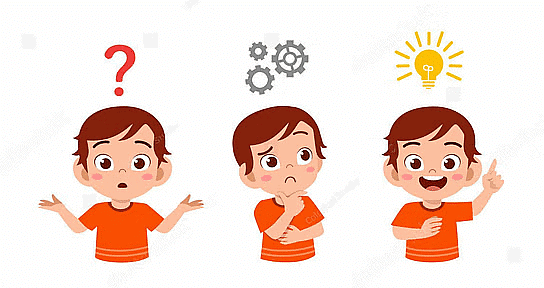Notes: Thinking and Learning in Children | Child Development and Pedagogy for CTET Preparation - CTET & State TET PDF Download
Learning goes beyond mere memorization or recalling facts. It involves thoughtful engagement facilitated by effective teaching, catering to learners from diverse segments and backgrounds within society. Thinking is the cornerstone of learning. When children develop their ability to think independently, the process of learning becomes more manageable. Therefore, enhancing thinking skills is the true measure of learning in students.

Before children begin formal schooling, they already start learning from various sources such as their family, friends, and their surroundings. By the time they enter school, they have already acquired basic skills like eating, washing, and basic social etiquettes.
Therefore, it is crucial for teachers to instill values that help children think rationally and develop critical thinking skills.
Children's Thought Processes and Cognitive Development
Children's thought patterns are fundamentally different from those of adults and are expressed in unique ways. Their cognitive development, categorized by Piaget into four stages, evolves over time:
- Sensorimotor: Birth to 2 years
- Pre-operational: 2 to 7 years
- Concrete operational: 7 to 11 years
- Formal operational: 11 years and above
Thinking Processes in Children
The thinking processes in children are based on several factors:
- Observation: Children learn and develop their thinking by observing objects and situations in their physical and psychological environment.
- Imagination: Children can use their imagination to learn and decide future behaviors, even if the person or object is not physically present.
- Concepts: Understanding concepts such as location, weight, time, distance, and numbers requires higher-level thinking for children.
- Experience: Children draw conclusions from their favorable or unfavorable experiences, influencing their observations and learning.
- Interest/Desire: Children develop new ways of thinking driven by their interests and desires. Encouraging curiosity accelerates their learning.
- Imitation: Children observe others' actions and their outcomes, leading them to imitate and enhance their abilities accordingly.
Logic and Reasoning
Logic and reasoning are crucial aspects of children's cognitive development and language skills:
Deductive Reasoning:
Also known as top-down logic, starts with a general statement and narrows it down to a specific conclusion. For example:
- General statement: "All green plants need sunlight."
- Specific example: "This rosebush is a green plant."
- Conclusion: "Thus, this rosebush needs sunlight."
Inductive Reasoning:
Also known as bottom-up logic, starts with specific observations and attempts to generalize. However, this reasoning may not always be factual. For example:
- Observations: "My bicycle has a flat tire" and "My bicycle is black in color."
- Incorrect conclusion: "Thus, black-colored bicycles have flat tires."
Inductive reasoning is less reliable than deductive reasoning because it goes from limited experiences to a generality.
Steps to Improve Thinking in Children
Parents and teachers play a crucial role in developing children's thinking abilities:
- Encourage children to think and articulate their thoughts through language development.
- Develop children's interests, as thinking is closely linked to curiosity.
- Assign age-appropriate tasks and responsibilities to encourage children to think about managing their duties successfully.
- Teach children problem-solving skills to tackle everyday challenges on their own, providing knowledge appropriate to their age.
- Encourage children to discuss their issues with parents and teachers if they are unable to solve problems independently.
- Create a learning environment that emphasizes the importance of thinking and learning.
Theories of Learning in Children
Various experts have proposed theories on how children learn:
The most notable theory was proposed by Edward Thorndike, known as 'Connectionism'. According to Thorndike:
- Learning results from associations formed between Stimuli (S) and Responses (R).
- These associations or 'habits' are strengthened or weakened based on the nature and frequency of S-R pairings.
- Thorndike's 'Laws' of learning include:
- Law of Readiness: Learning occurs when there is a readiness or preparedness for action.
- Law of Exercise: Practice increases the efficiency and durability of learning.
- Law of Effect: The Law of Effect states that learning is strengthened by satisfying outcomes and weakened by unsatisfying outcomes:
- Satisfying responses strengthen learning and are selected.
- Dissatisfying responses are eliminated.
- Greater satisfaction increases the motivation to learn.
Subordinate Laws
Besides the basic laws, Thorndike referred to five subordinate laws that further explain the learning process:
- Multiple-Response: Children vary their responses until a suitable behavior is found.
- Set or Attitude: Learning is more effective if the child has a positive attitude toward learning.
- Pre-Potency of Elements: Children react selectively to important elements and neglect irrelevant ones, similar to the Gestalt theory.
- Response by Analogy: Children use elements from past situations to respond to new situations.
- Associative Shifting: Children give responses associated with other situations they are sensitive to.
Children’s Failure in School
Children may fail in school due to various reasons:
- Fear: Fear of failure, humiliation, or disapproval can hinder learning and progress in the classroom.
- Boredom: Repetitive tasks and lack of engagement can lead to boredom and disinterest in learning.
- Confusion: Contradictions between home and school learning and unanswered questions can cause confusion.
- Poor Teaching Strategy: Ineffective teaching methods that do not match children's interests or capabilities can lead to defensive behaviors.
- Lack of Motivation: Lack of communication, little interest in academics, and misunderstood classroom environments can demotivate children.
- Absence of Social Skills: Social difficulties such as teasing, bullying, and loneliness can disconnect children from the school environment.
Solutions to Tackle and Avoid Failure
Parents and teachers can take proactive steps to prevent and address children's failure in school:
- Involvement of Parents: Parents play a crucial role in showing appreciation for academic achievements and providing learning opportunities outside the classroom.
- Skill Development: Both teachers and parents should help children develop reading, writing, mathematical, organizational, and social skills.
- Increase in Motivation: Providing constant positive feedback and support will increase a child’s motivation and self-esteem.
|
67 videos|154 docs|41 tests
|
















